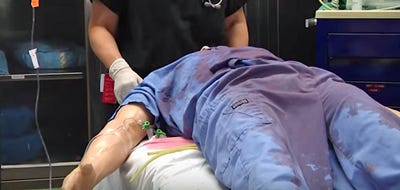How to Freeze Trauma Patients to Save Their Lives
October 4, 2016
University of Pittsburgh Medical Center researchers are testing induced hypothermia as a way to save trauma patients' lives. The new method could give doctors more time to stop bleeding and minimize brain damage, but better devices and techniques are needed.
Kristopher Sturgis
 The U.S. Department of Defense five years ago began funding a new study called the Emergency Preservation and Resuscitation for Cardiac Arrest from Trauma study, or simply the EPR-CAT study. The study would focus on the use of induced hypothermia, a unique method of treatment that would enable trauma experts at the University of Pittsburgh Medical Center (UPMC) to attempt to rescue patients who had suffered cardiac arrest due to massive bleeding.
The U.S. Department of Defense five years ago began funding a new study called the Emergency Preservation and Resuscitation for Cardiac Arrest from Trauma study, or simply the EPR-CAT study. The study would focus on the use of induced hypothermia, a unique method of treatment that would enable trauma experts at the University of Pittsburgh Medical Center (UPMC) to attempt to rescue patients who had suffered cardiac arrest due to massive bleeding.
The technique involves chilling the patient to nearly 50 degrees below normal body temperature to decrease the body's need for oxygen, so additional treatment can be performed without damaging the brain and other vital organs. Samuel Tisherman, M.D., director of the Center for Critical Care and Trauma Education at UPMC and leader of the study, says that the focus of the study is on trauma patients in critical condition who are running out of time.
"Our focus has been on how to save trauma patients who have bled so much that they have suffered a cardiac arrest," he said. "CPR does not work in this situation, as there is no blood to pump. Surgeons face a race against the clock to stop the bleeding before irreparable damage is done to vital organs, particularly the brain. Since hypothermia decreases the need for oxygen, we felt that it could hold promise for 'buying time' for surgeons to control the bleeding. We call this approach, 'Emergency Preservation and Resuscitation' or EPR."
A major challenge to overcome involves developing new medical devices and techniques to ensure cooling is both safe and efficient. "For this to further expand, we hope to develop devices that can make it easier for implementation, but that's probably several years down the road," Tisherman said.
Beginning in February of this year, Tisherman and his colleagues began screening ER patients in search of a specific kind of trauma victim--one that had experienced gunshot or knife wounds with excessive bleeding, to the point of cardiac arrest. These patients would have little time, and would likely be ideal for EPR treatment.Tisherman and his colleagues look to build on the approach that other doctors have taken in the past when it comes to the use of mild levels of hypothermia to help the brain recover from non-traumatic cardiac arrest.
"Our study is different than some work that has been done in the past 15 years on the use of fairly mild levels of hypothermia to help the brain recover after a non-traumatic cardiac arrest," he said. "We are looking to rapidly cool the patients to much deeper levels of hypothermia, 50 °F, to drastically decrease the need for oxygen. This sort of cooling is used for some operations on the aorta or the heart, during which the surgeon must stop all the circulation in the body. In that situation, the surgeon can control when the cooling begins and when the circulation is stopped. We are dealing with a situation where cardiac arrest has already occurred. We hope to show that this can save trauma patients that currently are not salvageable."
The induced hypothermia procedure is designed to provide doctors with about an hour's worth of time to stop excess bleeding and operate without worrying about brain damage from lack of blood flow. With the body at normal temperatures, that window of time is usually less than 5 minutes, and is oftentimes a major contributing factor that leads to death in trauma patients.
Once the patient is stabilized using EPR treatment, the team would then use a heart-lung bypass machine with a heat exchanger to slowly restore oxygenation, blood circulation, and body temperature as part of the resuscitation process. Surprisingly, Tisherman says the most challenging aspect isn't recovering from EPR treatment, but rather developing a cooling technique that is both efficient and safe.
"The biggest challenge for us is trying to cool the person to these very low levels of temperature as fast as possible," he says. "Our laboratory experience has suggested that pumping a very large volume of saline directly into the aorta seems to be the fastest approach to cool the vital organs. For cardiac surgical cases with this cooling technique, they can wake up later the same day. For our patients, how quickly they recover will likely be more related to the original injuries, and the cardiac arrest that had already occurred before we initiated the therapy."
Given the low odds of survival for patients suffering from this kind of trauma, Tisherman believes that any kind of therapy that can improve survival rates is worth further exploration and research --and he believes this method could save more lives.
"If we can show that this works, many trauma centers could learn how to do this and implement it within months to a couple of years," he says. "Right now, at best, 5% of patients who suffer cardiac arrest from trauma can survive. If we can prove that this works, we could save many more trauma patients."
Kristopher Sturgis is a contributor to Qmed.
Like what you're reading? Subscribe to our daily e-newsletter.
[Image courtesy of University of Pittsburgh Medical Center]
About the Author(s)
You May Also Like

.png?width=300&auto=webp&quality=80&disable=upscale)
